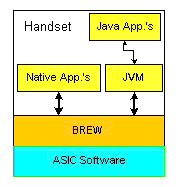
First of all, BREW™ is an acronym that stands for Binary Runtime Environment for Wireless. From a software developer's perspective, Qualcomm®'s BREW can be viewed as:
1. A set of APIs that enable developers to create software applications for wireless devices (wireless phones for now), and
2. A means of selling and delivering applications to end-users.
On the phone itself, BREW is a thin client (about 150K) that sits between a software application and the Application Specific Integrated Circuit (ASIC) level software. Thus developers can write to BREW without knowing or caring about the device's chipset or air interface. While it's true that CDMA is Qualcomm's specialty, BREW is equally capable of running on devices that employ other air interface standards. Figure 1 shows the conceptual layering of software on a wireless device.
The second major component of BREW is the BREW Distribution System (BDS). The BDS encompasses end users' ability to shop for, purchase, download, and install software over the wireless carrier's network.
The BREW Shop lets users browse the carrier's Application Download Server to see what applications are available for purchase or trial. The entire transaction is completed over the air. The carrier generates a billing record for each purchase and a corresponding charge appears on the subscriber's monthly phone bill.
The carrier retains any retail markup and shares 20% of the application's wholesale price with Qualcomm. The remaining 80% of the wholesale price flows to the developer.
Developing BREW Applications
BREW applications can be written using Java™, C, or C++. At the 2002 BREW Developers Conference, held in early June in San Diego, IBM® and Insignia® demonstrated Java Virtual Machines for BREW. Hewlett Packard® (HP) has also ported its MicrochaiVM™ to BREW. IBM will offer a BREW development plug-in with its WebSphere Studio Device Developer™ product.
This series of articles will focus on C and C++ development for BREW, as supported by the freely available BREW SDK. Note that there are presently 3 versions of the SDK available: 1.0, 1.1, and 2.0. Each SDK version is paired with a corresponding Application Execution Environment (AEE) on the phone. Applications written using the 1.0 SDK will run on phones equipped with later versions of the AEE. The converse is not necessarily true since each successive version incorporates new capabilities.
Since the provision of BREW updates for existing phones is unlikely, maintaining compatibility with version 1.0 is advisable if you want to maximize the size of your target market. Nonetheless, versions 1.1 and, particularly, 2.0 do offer significant incremental functionality. To learn more about the differences, download the 1.0 SDK and flip through the API Reference (754 pages). Then follow the 1.1 and 2.0 "What's new" links from the download page.
While it's true that the SDK is free of charge, the developer must have at least version 6.0 of Microsoft Visual C++™ in order to develop and test applications using the BREW Emulator™ supplied with the SDK. The emulator is a Windows™ program that simulates the AEE on a phone. An application runs on the emulator as a Windows .dll. The emulator is a good tool for learning the APIs and testing an application throughout the development process. Be forewarned that there are significant differences between the emulator environment and the phone itself. Developers should incorporate actual hardware and frequent native builds early in the development process, in order to avoid convoluted debugging issues down the line.
When a developer decides to take the leap and commence commercial development, several additional costs must be incurred at various stages of the project. First of all, in order to gain access to tools fundamental to development on actual hardware, the developer must be authenticated. In essence, developer authentication involves an outlay of $400 for a Verisign Authentic Document Digital ID™, good for one year from date of purchase or the digital notarization of 100 applications, whichever comes first.
Authentication gives the developer access to the BREW Developer Extranet™ where several important tools can be accessed and/or downloaded. For example, the BREW ClassID Generator™ assures the provision of a unique, 32 bit ID for each application. The BREW TestSig Generator™ provides a digital signature that allows a developer to test an application on actual hardware. Additionally, the BREW AppLoader™ downloads applications onto phones.
Beyond authentication, there are other costs. The CPU used in BREW phones is currently an ARM7TDMI®. Since C and C++ applications run natively on the device, an ARM® compiler is required. Qualcomm presently supports ARM BREW Builder™ ($1,500), ARM Developer Suite (ADS) 1.0.1™, ADS1.1™, and possibly ADS1.2™. Given that ADS1.2 costs $5,500 for a node-locked license and $6,500 for a floating license, the $1,500 price tag for BREW Builder looks like a steal of a deal! A free, 45-day, evaluation version of ADS1.2 is available.
The developer will also need a BREW phone for testing applications. Presently only 2 models are commercially available: the Sharp® Z800™ ($399.99 from Verizon Wireless®) and the Kyocera® QCP3035e (price unavailable, though certainly less than the Z800). Note that both of these phones have version 1.0 of the AEE, thus applications targeting these devices must be developed using version 1.0 of the SDK. Three new phones, equipped with version 1.1 of the AEE and a CDMA 1x air interface, are due to hit the market as early as September 2002. Pricing information is currently unavailable. Phones with version 2.0 of the AEE are expected late in 2002 or early in 2003.
As shown by Figure 2, TRUE BREW™ certification testing, conducted by NSTL™, represents another potentially significant cost for the developer. An application must pass TRUE BREW certification before a carrier will make it available on their network. Certification aims to ensure that carriers' networks remain free of viruses and malicious or unstable applications.
No comments:
Post a Comment